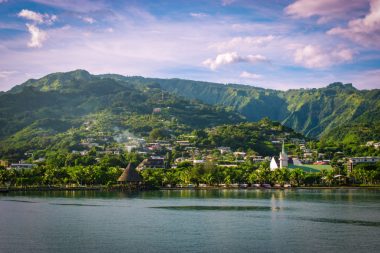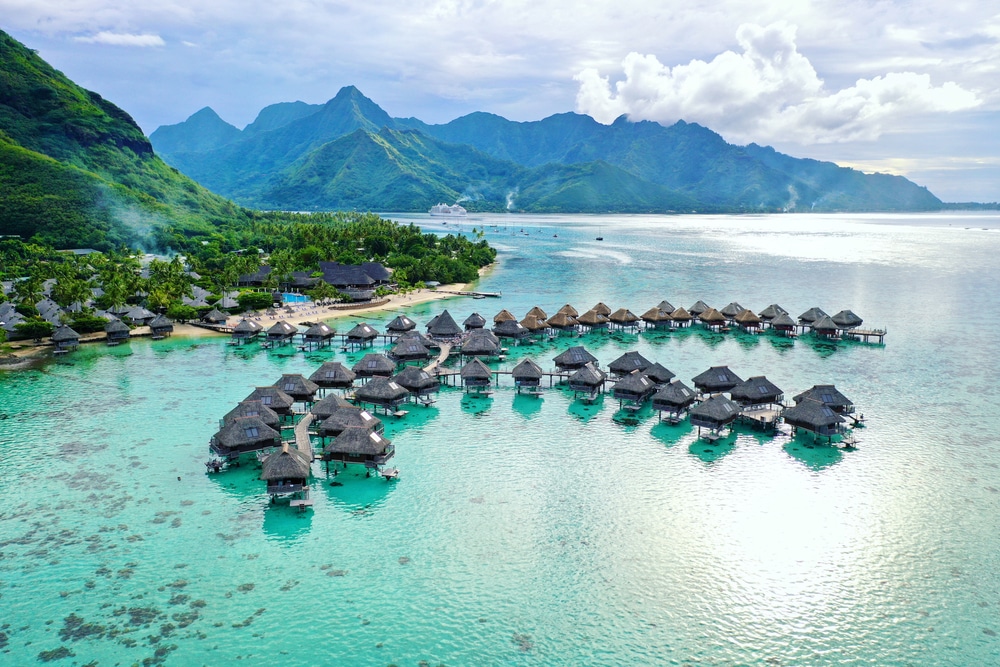The island region of Polynesia consists of many islands, as the name, which is derived from the Greek, already bluntly reveals. More precisely, from over 1000 islands, most of which are uninhabited.
The Polynesian Triangle, which has Hawaii, New Zealand and Easter Island as its cornerstones, covers an area of almost 50 million km², of which about 294,000 km² is forfeited to the landmass. New Zealand makes up the majority of the country.
Polynesia brings together a wide variety of cultures. The diverse traditional island culture has mixed with the Western cultures of Britain and France since the 18th century, but the locals have been successful in keeping their pre-colonial customs alive.
Islands of Polynesia
Tahiti – Showcase Island

Tahiti is the largest island in French Polynesia and a member of the Society Islands. It is divided into Greater and Little Tahiti.
Tahiti is the island paradise par excellence: white sandy beaches, palm trees and a picturesque sea full of colorful fish. But there are also fascinating landscapes on the island. Black beaches, steep mountains and waterfalls provide hikers with a breathtaking backdrop. Museums and archaeological sites provide insights into the history of the island and culture. Papeete was elevated to the capital of Tahiti by the indigenous Queen Pomaré IV before 1830. Since the 1960s, it has had an airport and is a popular docking place for cruise ships.
Moorea – In the heart of Polynesia
17 kilometers from Tahiti is the island of Moorea. Here, too, the clearest water, picture-book beaches, high mountains and exotic flora beckon.
According to legend, the island with the striking silhouette is the dorsal fin of a huge fish.
Although Tahiti may be a little more famous, many travelers agree that Moorea is the most beautiful island in Polynesia. As early as the 18th century, this was agreed to by the explorer William Ellis.
Maupiti – The Untouched
Maupiti stands out from the rest of the islands above all with its authenticity. Its natural beauty can be easily explored on hikes, and by staying in inns run by the locals themselves, you are much closer to the culture than on the tourism-focused islands.
Of course, boat tours are also offered here and there are also some archaeological sights. Otherwise, however, the island, which is called Marua Ite Ra by the locals, is rather decelerating. The island lives from its originality and that is exactly what makes it so appealing.
But you can also visit the sister islands of Raiatea and Tahaa from Maupiti. Legend has it that Maupiti was chased away by them because of their outstanding beauty.
Bora Bora – Polynesia for all
Along with Tahiti, Bora Bora is certainly the most famous island in French Polynesia. It offers tourists the most ideal holiday conditions all year round, its beaches seem to have come straight out of a travel magazine and clubs, shops and restaurants are lined up close together in the city.
Numerous festivals and other events serve to introduce the traveler to the local culture.
In short: Bora Bora is the perfect destination for diving enthusiasts, party animals or a romantic holiday under palm trees.
Rangiroa – Paradise in the Pacific
East of the Society Islands lies the Tuamotu Archipelago, whose largest atoll is called Rangiroa (“Endless Skies”). Named after the clarity and expanse of the lagoon, travelers can now already guess what to expect.
The 80-kilometre-long ring is picturesquely situated in the blue of the Pacific and offers sand and palm trees, folklore and tradition. In addition to tourism, the inhabitants of the three villages live mainly from fishing and pearl fishing. The island also exports copra, the nutrient tissue from which coconut oil is extracted.
The island is particularly popular with divers. Coral reefs and colorful fish create a wonderful underwater world that hardly anyone wants to miss.
Raiatea – Cultural Center of Polynesia
The atoll of Raiatea is part of the Society Islands and shares a coral reef with its neighboring island of Tahaa. The capital of the island offers only a few sights.
The real treasure of the island is undoubtedly the cult site of Marae Taputapuatea. It is one of the most important in all of French Polynesia, but not the only one on the island.
The island is also a true pearl of the ocean for hikers and nature lovers. A rich endemic flora and a wide variety of landscapes come together to create a wonderful panorama.
Nuku Hiva – Nature, Culture and History
Nuku Hiva, like Raiatea, has several ceremonial platforms, as well as rock engravings and tiki statues.
Unique landscapes, such as the Vaipō Waterfall, which is one of the highest waterfalls in Polynesia at 350 meters, or the Taipivai Valley can also be found here.
Literature lovers take note: Scottish writer Robert Louis Stevenson’s favourite place is also located on the island. The island is also the setting for Herman Melville’s story Taipi and is mentioned in Jules Verne’s novel “Paris in the 20th Century”.
It should also be interesting that Nuku Hiva served as a deportation for a short time in the middle of the 19th century. For example, some revolutionaries of the June Uprising of 1848 were exiled here with their families.


